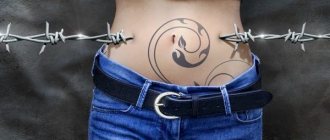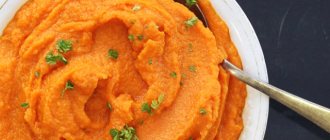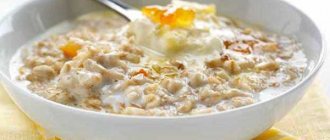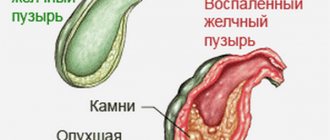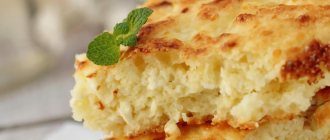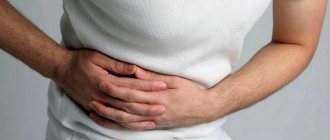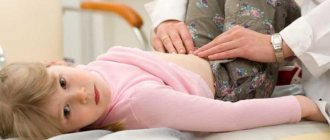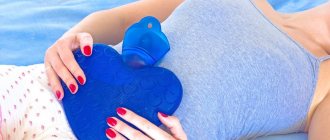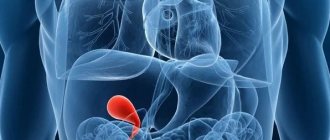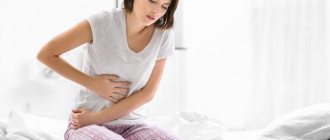7357
As a result of poor nutrition and a sedentary lifestyle, diseases of the liver, pancreas and gall bladder can occur. Dysfunction of these organs leads to serious complications. In order to avoid this, doctors prescribe a special diet along with the main treatment.
Therapeutic nutrition involves:
- variety of food;
- reducing calories consumed per day;
- reducing the diet of fats and foods containing cholesterol.
Therapeutic diet No. 5, for diseases of the liver and gall bladder
Therapeutic diet No. 5 is a basic diet for diseases of the liver and gall bladder.
Indications for use, characteristics, list of permitted products along with a sample menu will help you navigate and create a menu yourself. Indications for use, characteristics, list of permitted products along with a sample menu will help you navigate and create your own menu.
It is the basis of treatment recommendations developed by Soviet doctors in the 60s of the last century.
Recommended Products
Having learned about their pathology, patients have no idea what they can eat if they have liver diseases, or how to organize their nutrition in the future. People who suffer from liver pathologies can eat a limited list of foods. This is due to the fact that the liver does not perform its functions fully and can cope with diseases only with the help of the owner. Doctors recommend that patients eat stale bread, durum pasta and cereals. If your liver hurts, this does not mean that you need to completely give up fats - they are allowed, but in limited quantities. Low-fat meat (rabbit meat, chicken) is best in this regard, and fats should be supplied to the body along with low-fat dairy products and fish (trout, cod, perch). This will be enough for the body to ensure vital functions. Dairy products include yogurt, kefir, fermented baked milk, low-fat sour cream, and cottage cheese. Egg consumption is limited - 1-2 per week in the form of an omelet, as there is a risk of exacerbation of the disease.
If you prepare the first courses, then the first broth needs to be drained and a little butter or sunflower oil added to them. It is best if the first courses are served not hot, but at room temperature. The same can be said for cold dishes - food should not be at too low a temperature.
A diet for the liver should include a lot of fiber; carrots, lettuce, beets, tomatoes, pumpkin, and zucchini will be useful in this regard. Among the sweet foods allowed, you can remember marmalade, marshmallows, jam, soufflé, meringue, berry mousses, compotes, and jelly. You can drink weak tea or juice.
https://youtu.be/GPCF5UJ-XUo
Therapeutic diet No. 5 is indicated:
- at the stage of recovery after acute hepatitis and cholecystitis;
- outside of exacerbation of chronic hepatitis;
- with cirrhosis of the liver, not accompanied by liver failure;
- outside of exacerbation of chronic cholecystitis and cholelithiasis.
Therapeutic diet No. 5 is prescribed only in the absence of severe gastric and intestinal diseases.
Therapeutic diet No. 5 is prescribed for the purpose of:
- chemical sparing of the liver with adequate nutrition;
- promoting the normalization of the liver and bile ducts;
- improving bile secretion.
Diet No. 5 is based on a physiologically normal content of proteins and carbohydrates with a slight limitation in the amount of fats, mainly refractory. Products rich in lipotropic substances, fiber, pectin, liquid, as well as products with low cholesterol content, nitrogenous extractives, purines, and oxalic acid are recommended. Dishes are boiled, baked, and rarely stewed. Stringy meat and vegetables with a lot of fiber are consumed pureed. Flour and vegetables should never be sautéed. A 5-6 meals a day diet is recommended.
Chemical composition of therapeutic diet No. 5
- 80 g of proteins, 55% of which are of animal origin;
- 80 g fats, 30% of which are vegetable;
- 350-400 g of carbohydrates, 70-80 g of which is sugar;
- 10 g salt;
- 1.5-2 liters of liquid.
If desired, you can consume 25-40 g of xylitol and sorbitol.
The energy value of diet No. 5 is 2400-2600 calories.
Product recommendations
Bread, flour products
Wheat bread made from first and second grade flour, rye bread made from sifted and peeled flour are allowed. The bread is recommended to be freshly baked. You can also eat savory pastries with boiled meat, fish, apples, cottage cheese, long-lasting cookies, and dry biscuits.
Excessively fresh bread, puff pastry and pastries, and fried pies are prohibited.
Soups can be vegetable, cereal with vegetable broth, dairy with pasta, or fruit. Vegetarian borscht and cabbage soup and beetroot soup are allowed. Soups should be seasoned with dried, not fried, flour and vegetables.
When prescribing therapeutic diet No. 5, soups with meat, fish and mushroom broths, okroshka, and green cabbage soup are contraindicated.
Meat and poultry
Lean meat without tendons and fascia and lean poultry without skin are allowed. Beef, young lean lamb, pork, rabbit, chicken, turkey can be boiled, baked after boiling in pieces or chopped. Stuffed cabbage rolls, pilaf with boiled meat, and milk sausages are allowed.
Fatty varieties, duck, goose, kidneys, liver, brains, smoked foods, canned food, and most sausages are contraindicated.
You can eat lean types of fish. The fish should be pre-boiled, baked in pieces after boiling, or included in quenelles, soufflés, and meatballs.
Fatty, smoked, salted fish and canned food are prohibited.
Dairy
Therapeutic diet No. 5 recommends the inclusion of milk, kefir, acidophilus, and yogurt in the diet. Sour cream can be used as a seasoning for dishes. Low-fat and half-fat cottage cheese can be eaten on its own and in the form of casseroles, dumplings, and puddings. Mild and low-fat cheese is allowed. Limit the amount of cream consumed, high-fat milk, fermented baked milk, sour cream, fatty cottage cheese, salty, fatty cheese.
A baked egg white omelette is recommended. A maximum of 1 yolk can be added to dishes daily. With normal tolerance, 1 soft-boiled egg or as part of an omelet is allowed.
Hard-boiled and fried eggs are prohibited. Patients with cholelithiasis are allowed up to half a yolk per day as part of a dish.
Cereals
Any dishes from any cereals are allowed, although preference is given to buckwheat and oatmeal. You can: pilaf with dried fruits, carrots, puddings with cottage cheese, carrots, krupenik, boiled pasta.
Bean dishes are contraindicated.
Vegetables
Raw, boiled, stewed vegetables are allowed in the form of salads, side dishes, and independent dishes. Also non-acidic sauerkraut, boiled onions, puree made from green peas.
Spinach, sorrel, radishes, radishes, green onions, garlic, mushrooms, and pickled vegetables are prohibited.
Snacks
Fresh vegetable salads can be seasoned with vegetable oil. Recommended are fruit salads, vinaigrettes, squash caviar, and boiled jellied fish. Also soaked, low-fat herring, stuffed fish, seafood salads, boiled fish, meat, doctor's, dairy, dietary sausage, low-fat ham, mild and low-fat cheese.
Spicy and fatty snacks, smoked foods, canned food, and caviar are prohibited.
Fruits, sweet
On diet No. 5, you can eat all fruits and berries, with the exception of sour ones, in any form: raw, boiled, baked. And also dried fruits, compotes, jellies, mousses, jelly, sambuca. Meringues, snowballs, marmalade, non-chocolate candies, marshmallows, honey, and jam are allowed in small quantities. Some of the sugar should be replaced with sorbitol and xylitol.
Chocolate, cream products, and ice cream are prohibited.
Sauces, spices
Sauces made from sour cream, milk, vegetables, and sweet fruits are allowed. Flour is not sautéed for them. You can add dill, parsley, as well as vanillin and cinnamon to dishes.
Mustard, horseradish, and pepper are not allowed in food.
Beverages
You can drink tea, coffee with milk, as well as juices from fruits, berries and vegetables. Decoctions of rose hips and wheat bran are extremely useful.
Black coffee, cocoa, and cold drinks are prohibited.
Butter can be consumed in its natural form or added to dishes. Refined vegetable oils are allowed.
Lard and cooking fats are prohibited.
Example of a therapeutic diet menu No. 5
First breakfast: cottage cheese with sugar and sour cream, milk oatmeal, tea.
Second breakfast: baked apple.
Lunch: vegetarian soup of mixed vegetables in vegetable oil, boiled chicken in milk sauce, boiled rice, dried fruit compote.
Afternoon snack: rosehip decoction.
Dinner: boiled fish with white sauce, vegetable broth, mashed potatoes, cheesecake, tea.
Authorized products
A diet for diseases of the gastrointestinal tract: gallbladder, liver and pancreas should take into account that the introduction of certain products can significantly alleviate or, conversely, aggravate inflammatory processes in the body. What products are recommended during the period of exacerbation of chronic hepatitis and pancreatitis of various origins: (calorie content per 100 g):
| № | Products | Norm /Kcal | Cooking options and notes |
| 1. | Low-fat fish: navaga, pike perch, cod, haddock, young flounder, hake, mullet, saury | Up to 90 Kcal | Traditional cooking, steaming, meatballs. |
| 2. | Lean meat: chilled chicken breast, turkey, lean beef, rabbit. | Up to 200 Kcal | Traditional cooking, steaming, meatballs, cutlets stewed in a mild sauce. |
| 3. | Low-fat fermented milk products, cheese, cottage cheese; | Up to 150 Kcal | Sour cream and cream products, fermented baked milk are excluded. |
| 4. | Flour and bakery products, wholemeal bread: oat bread, crispbread, soft white bread, crispbread, pancakes, pasta; | Up to 300 Kcal | It is allowed to prepare crackers and use them together with weak meat broth, dried bread, stale bread, and adding pureed bread to cutlets. Pasta is boiled and consumed without adding sauces. Pancakes are prepared in the traditional way. |
| 5. | Seafood: lightly salted seaweed, squid; | Up to 70 Kcal | It is allowed to consume only previously familiar products after thorough cooking. |
| 6. | Vegetables: tomatoes, greens, dill, cucumbers, carrots, onions, eggplants, bell peppers, radishes, lettuce. | Up to 40 Kcal and up to 90 Kcal in the form of vegetable caviar | Traditional cooking, blanching, stewing with meat pieces, grinding into mass (mashed potatoes or caviar), salads. |
| 7. | Fruits: sweet varieties: apples, pears, peaches, apricots, quince, | Up to 95 Kcal | Traditional cooking, mashing, baking, making compotes, preserves, fruit drinks. |
| 8. | Melons: pumpkin, melons, watermelons | Up to 80 Kcal | Pumpkin – lightly boiled, other crops – fresh, condition controlled. |
| 9. | Drinks: tea, compote, fruit drink. Compote is preferable mainly from dried fruits: dried apricots, prunes, raisins, dried berries. | Not installed | It is not recommended to add more than 1 teaspoon of sugar, because... this increases the load on the pancreas and contributes to weight gain. To increase the vitamin value of the drink, you can add a small amount of fresh non-acidic berries at the end of cooking. |
| 10. | Porridge: rice, buckwheat, pearl barley, oatmeal, whole grain porridge | Up to 400 Kcal (for rice porridge) | Regular cooking. |
| 11. | Eggs: chicken, quail | Chicken – 160 Kcal; Quail – 140 Kcal. | For quail - only hard-boiled, it is not recommended to mix with milk, as some enzymes are lost; For chicken - hard boiling, omelettes, Gogol-mogol cocktail: beat with sugar, first separating the protein. Use the latter option with caution and only on domestic eggs. |
| 12. | Sausage and sausage products: only boiled sausage, frankfurters, lean sausages; | Up to 280 Kcal | Sausages are consumed in their originally prepared form, both separately and in small sandwiches with soft bread or crispbread; The sausages are boiled. |
| 13. | Vegetable oils: olive, rapeseed, avocado oil, sunflower | Up to 900 Kcal | Salad dressing, minor addition to sauces, you can drink a teaspoon for pain. |
| 14. | Nuts: hazelnuts, walnuts, almonds. | Up to 710 Kcal | It is recommended to consume it only in raw form; fried increases the load on the liver and pancreas. |
| 15. | Sweet products: honey, slightly sweet jams | Up to 590 Kcal | Recommended in small quantities as an additive to cottage cheese, tea or pancakes. |
The table includes conditionally acceptable products for exacerbation of chronic diseases of the digestive tract. However, there are restrictions on the consumption of foods for each disease separately, as well as general prohibited types of food for gastrointestinal pathologies.
Basic principles of diet therapy
Since there is great similarity in the functional activity of the liver and gallbladder, when inflammation occurs in one organ, neighboring structures are inevitably involved in the process. The person begins to experience unpleasant sensations in the area of the right hypochondrium, the appetite changes and overall health worsens.
Properly selected diet therapy helps people get rid of this disorder. Experts recommend table No. 5, since it best suits the needs of the body during the development of the disease. Basic principles of the diet:
- moderate reduction in calorie content of dishes – 2400–2700 kcal/day is acceptable;
- reducing the volume of fats and foods with cholesterol – no more than 90 g/day;
- compliance with the drinking regime – 1.5–2 liters. clean liquid per day;
- minimizing the amount of table salt;
- gentle ways to process food - cook in a double boiler, boil, bake in the oven without oil;
- the temperature regime of ready-made dishes is gentle - hot/cold food worsens the condition of the organs;
- divided meals - small portions, but 4-5 times a day.
Authorized Products
When the digestive structures of the hepatocellular region are affected, the menu for every day must include first courses. It is better to cook soups with vegetable broth. Whereas meat and rich options should be prohibited, as they increase the formation of bile and the production of enzymes. This increases inflammation in hepatocytes.
The basis of dietary first courses is vegetables and cereals, as well as egg whites and lean varieties of fish and meat. The cold version of the soup, okroshka, is absolutely prohibited. Whereas pasta made from higher grades of flour is fully approved in the diet for diseases of the gall organ or liver. It is better to boil the cereals well and make slimy porridge from them.
Bakery products, as well as baked goods, are acceptable in a stale form - yesterday's. It is better to give preference to homemade crackers, without spices or additives. Vegetables should not contain oxalic acid. They are steamed and eaten raw – in salads. Marinades and preservatives aggravate the inflammatory process in the bile bladder and are therefore prohibited.
The diet for gastrointestinal diseases allows almost all fruits, but without the sour taste. They can be baked or eaten raw as an afternoon snack. Compotes with jelly improve well-being in case of liver disorders.
From meat dishes, you should choose lean varieties - chicken, rabbit or turkey. They are cooked in a double boiler and baked in foil. You can rarely include cutlets in the menu. Whereas by-products are not allowed by the diet during exacerbation of a pathological focus in the liver. They are replaced by certain types of fish - hake or pollock have proven themselves well.
Tips and tricks
To get a good result at the end of the liver cleansing diet, you should listen to the following recommendations and advice:
- You can’t suddenly leave the diet menu - this will immediately overload the rested digestive system . The first week you need to behave extremely carefully and continue to refuse junk food;
- Any cleansing diet involves drinking large amounts of purified water. This reduces appetite and promotes rapid elimination of toxins. Mineralized alkaline water can also be present in the diet, but not be the main drink. You need to drink at least two liters of water per day;
- The last meal should be no later than 2 hours before bedtime. If you are unable to eat and your hunger does not subside, then you can drink a glass of milk or eat one egg, but meat and fish are prohibited - these products take about four hours to digest;
- the diet should contain enough refined carbohydrates - they are the most nutritious and satisfy hunger for a long time;
- If the impetus for changing your diet and switching to a diet to cleanse the liver was any discomfort, you should first undergo an examination. You need to carefully study the nature of the problem, donate blood and look at the gastrointestinal tract and liver on an ultrasound, and then choose a treatment option .
If any gastrointestinal or liver diseases are present, the diet must be approved by a doctor. An individual nutrition menu for each day is developed for the patient, which should take into account the needs and not overload the suffering organ. In this case, it is better not to joke with choleretic drugs and drugs - the rationality of their use is assessed by the doctor in each specific case.
The liver is the main filtering organ that protects a person from the effects of poisons and takes on many vital functions. It is unique because it is capable of completely restoring its cells from a quarter, which is why it is often transplanted, saving numerous lives. Following a diet to cleanse the liver at least once a year reduces the risk of liver failure and increases the resistance of the digestive system in general, especially in case of poisoning.
Popular first courses
Delicious and healthy recipes for dishes for diseases of the liver, pancreas, and gall organ can be selected for every day. A doctor will recommend them, or you can search on special sites on the Internet where people exchange their opinions about healthy foods:
- Pearl barley soup is great during acute periods when a strict diet is required. You need to take 20 g of pearl barley, rinse and cook for a long time over moderate heat - at least 2.5 - 3 hours. Rinse the carrots thoroughly and peel them, then chop and simmer in a frying pan with a small amount of vegetable broth. Later, pour in the remaining broth, and place the already diced potato tuber there. Add salt to taste. Before serving, add a small amount of herbs.
- Beetroot - has long been part of the diet for liver diseases. For each serving you will need to boil and cut into strips 100 g of beets. Then chop 100 g of fresh cucumbers. Then finely chop 25 g of green onions. After boiling the hard-boiled egg, chop it into cubes. Place all products in beet broth, lightly salt. Sprinkle finely chopped parsley on top.
- Milk noodle soup. Knead the dough from 40 g flour and ¼ egg. Roll it out thinly and prepare homemade noodles. It is introduced into boiling water gradually, stirring constantly. Cook for about 10-15 minutes. Then pour in 300 g of milk already heated to a boil. Add a little salt and sugar to the finished dish.
Prohibited Products
No less important in a diet for diseases of both the liver and gall bladder is minimizing harmful foods that can cause deterioration of digestion. Completely prohibited:
- fatty meat and fish options - as they increase the load on the digestive structures;
- rich meat broths;
- mushrooms;
- carbonated and alcoholic drinks - they provoke flatulence and intoxication in the organs;
- radish and mustard with garlic - they irritate the gallbladder mucosa and can aggravate inflammation in the liver.
If you have liver diseases, you will have to minimize, or better yet avoid, the food “joys of life”:
- confectionery - cakes with pastries, especially with rich cream;
- fresh buns;
- cold okroshka;
- sweets containing cocoa;
- green cabbage soup;
- all types of legumes;
- tomatoes and sauerkraut;
- asparagus and green onions;
- spinach and lemon;
- goose/chicken liver pate;
- offal;
- smoked meats;
- sausages;
- coffee-containing drinks.
Vegetables and fruits from the list of healthy foods are moved to the list of prohibited foods for liver diseases if they have been canned, even in a sweet marinade - compotes, preparations for soups for the winter.
How to help the liver work properly
First of all, you need to avoid foods that negatively affect this organ.
Eat smoked, spicy, fatty, pickled foods as little as possible - these are the main enemies of the liver. Do not eat foods that have been processed - sterilized, pasteurized, or containing dyes or preservatives. All this only adds to the work of the liver.
Sausages and sausages, ready-made minced meat contain nitrates and also put too much strain on the liver.
She does not like sour berries, as well as radishes, garlic and radishes.
Avoid fast food, fatty and sweet pastries and cakes, and alcohol. After all, after drinking alcoholic beverages, the body receives serious poisoning, and the main blow falls on the liver. And if you regularly expose it to such a load, then even a healthy liver will not be able to withstand it - normal liver cells will degenerate into fat cells, and the body will be left with virtually no protection.
https://youtu.be/gAcbl-6roXA
Diet after gallbladder removal
Despite the development of modern medicine, certain diseases - for example, large stones formed in the gallbladder - require urgent measures - surgical removal of the organ. In this case, a particularly strict diet is required - in the first 4-6 months after surgery.
Thanks to a properly designed menu, the rehabilitation period will be easier and your health will improve faster. The basics of diet therapy after removal of the bile organ are explained to the patient by the attending physician.
So, for 1-2 days you will have to give up food altogether - drink clean water and rosehip decoction in small portions. From the third day, the diet is strictly gentle, but expanded - mashed potato tubers, without oil or vegetable soups, chopped in a blender, weak tea. Portions must be small, meals 8-10 times a day.
Then, for 2.5-4 months, the patient adheres to the recommended diet at home, so as not to provoke an exacerbation of the disease - for example, colic in the bile ducts of the liver. Authorized products:
- steamed protein omelettes;
- meatballs from lean meats/fish;
- vegetable and fruit purees;
- slimy porridge on water;
- soups in low-fat broths with vegetables.
Diet after liver surgery
After liver surgery, a balanced diet is indicated. Doctors prescribe a diet depending on the extent of the intervention performed and the complexity of the situation. Dietary restrictions are observed on average in the first three to five days, when patients are shown only water, liquid cereals, and weak broths made from lean meat. Over the next five days, you can gradually transfer patients to another type of nutrition, gentle. The diet will take into account the fact that the liver cannot perform its functions, the activity of the stomach and intestines is inhibited, and secretion is impaired. A gentle diet should last at least ten days. In some cases, patients cannot eat on their own, and nutritional mixtures are administered through a tube. As a rule, this is done by qualified medical personnel. After ten days, patients are transferred to table No. 0-a, after which they are prescribed nutrition according to the principles of table 1- and 1-b. Any other diets are prohibited at this time. The prescribed diet is followed for approximately three weeks, after which patients are transferred to table 5-a. If problems arise with such nutrition, a gentle fifth table is prescribed. Treatment of patients after surgery requires strict adherence to dietary principles; any changes in nutrition can lead to serious consequences.
If you follow proper nutrition for liver disease, you can achieve good results in the treatment of pathologies of this organ. If you do not violate the doctor’s instructions, the liver will quickly restore its functions and you can eat as before.
Sample menu for the week
It is recommended to distribute foods in the diet for diseases in the tissues of the liver and gall bladder in advance - create the correct menu together with your doctor. Then just stick to it for about six months.
- On Monday, it is better to give preference to rice mucous porridge for breakfast. Then how about making a casserole from curd mass for the second breakfast. At lunchtime, cabbage soup with a second broth will replenish your strength, as well as boiled lean meat with stewed carrots. For an afternoon snack you can have a baked green apple. And for dinner - pasta with cheese sauce.
- Tuesday starts with apple and carrot salad. In addition, you can steam a meat cutlet. For second breakfast - pear, preferably baked. For lunch - mashed potatoes with a side dish of stewed cabbage without oil, as well as steamed fish. For an afternoon snack, make do with a biscuit with rosehip infusion. For dinner, prefer a casserole with vegetables and buckwheat.
- Wednesday. For breakfast - milk soup with oatmeal or pasta. Whereas for second breakfast - apple salad with carrots. For lunch you can indulge in boiled chicken with rice, as well as vegetable soup. For an afternoon snack - juice from non-acidic fruits with vanilla crackers. It is better to have dinner with stewed fish and a boiled potato side dish.
- Thursday. For breakfast, curd mass with a drop of honey. For second breakfast - boiled pasta without oil. Lunch – lazy cabbage rolls or pureed vegetable soup. In the afternoon - a glass of low-fat kefir. Dinner should be light - for example, rice porridge with milk, but without butter.
- Friday. For breakfast – boiled buckwheat with a piece of butter. For second breakfast - carrot casserole. For lunch - vegetable borscht in lean broth, for the second course - pasta with fish balls. For an afternoon snack - any permitted fruit. It is better to have dinner with vegetable puree and portioned fish, or in the form of an omelet.
- Saturday. For breakfast - oatmeal with dried fruits. For second breakfast - steam omelette from 1 egg. For lunch - milk soup, cottage cheese casserole. For afternoon snack – juice and biscuit. For dinner - semolina porridge with prunes.
- On Sunday, try to ease the work of the gastrointestinal tract, especially with chronic diseases - small portions of vegetable soup, juices from non-acidic berries, jelly, allowed pieces of fruit.
Possible complications without diet
The human body is a finely organized system in which each organ functions together with neighboring structures. For diseases of the liver and gallbladder, a diet is necessary, since without it the other systems suffer.
If a nutritionist’s recommendations are not followed, a person experiences negative consequences:
- constant feeling of heaviness in the liver area;
- tendency to flatulence and defecation disorders;
- steady weight loss;
- deterioration of the condition of the skin, nails, hair;
- frequent exacerbation of chronic diseases;
- addition of infectious complications;
- decreased ability to work;
- relapses of gastrointestinal diseases.
A proper diet is the key to good health for every person. A menu selected with your doctor will help preserve and strengthen the health of your liver and gallbladder for many years.
Diet goals
If a gallstone is diagnosed, the diet in this case is table No. 5. They adhere to a similar diet in order to reduce the load on the liver, intestines and neighboring organs. Other goals of nutrition correction:
- exclusion of bile stagnation, as well as disruption of the bladder itself;
- combating complications of gallstone disease - they provoke malfunctions of the liver, intestines, and pancreas;
- reduction of symptoms of clinical manifestations of cholelithiasis, neutralization of signs of nausea and pain;
- prevention of colic in the gallbladder area and other complications that require urgent surgical intervention with a high probability of injury.
Gastroenterologists recommend that patients keep a special diary in which they will make daily records of the foods consumed and the total number of calories
It is important to consider that nutrition should not conflict with the use of medications and other rehabilitation measures
Share the article on social media. networks:
Therapeutic diet for gallbladder and liver disease, weekly menu and dietary recipes
For all forms of liver and gallbladder diseases, dietary nutrition is a necessary auxiliary measure to drug therapy. Eating healthy foods will eliminate problems with the outflow of bile, prevent stagnation, improve your general condition, and increase the effectiveness of pharmaceutical drugs prescribed by your doctor. The diet for liver and gall bladder diseases has a number of features, so it is better to familiarize yourself with the principles of proper nutrition in advance, understand the requirements for cooking, and create the most healthy menu.
Duration of the diet and retention of results
The cleansing diet is designed for a month, there are express diets for a week, although it may take longer, depending on how you feel. When using a cocktail or other supporting agents, the effect of the diet will be 1-2 weeks.
Under no circumstances should you suddenly switch to your usual diet after cleansing, especially if it is far from healthy. This threatens the return of lost pounds and skin problems, as well as serious health problems. You need to return to your usual food gradually, but it is better to eat properly throughout your life.
There are no seasonal restrictions for cleaning, but it is more logical to carry it out in the summer, when a variety of vegetables, fruits and herbs are available. The body absorbs seasonal foods better, since in winter most of them contain a heavy dose of nitrates.
Diet for liver and gallbladder diseases: useful advice from nutritionists
In order for a diet for gallbladder disease to bring the greatest benefit, it is recommended that you familiarize yourself with the requirements of nutritionists. Following the following nutritional rules will help improve your overall health and normalize organ function:
- eat first courses daily, it is better to cook in vegetable broth, do not use concentrated fatty broths, okroshka or sour cabbage soup should also be excluded from the diet;
- refuse to eat fresh baked goods, give preference to slightly stale bread, biscuits, and crispbreads;
- Be sure to include cereals in the menu - cook porridge in water, adding a small amount of milk and butter is allowed, while continuing to cook, make sure that the dish is slimy and boiled;
- if vegetables are consumed, find out whether the fruits contain oxalic acid, which is dangerous for the liver and gall bladder;
- be sure to include fruits in your diet - unlike diets recommended for most ailments of the digestive tract, fruits do not have to be subjected to preliminary heat treatment; it is allowed to consume the healthy product in its raw form;
- You should be prepared for long-term dietary restrictions - depending on the degree of the disease, the diet for a diseased gallbladder will have to be followed for up to a year.
Nutritionists warn that if difficulties arise with regulating your diet on your own, it is better to seek the help of a doctor. Usually, a therapeutic diet 5 is prescribed; for diseases of the liver and gall bladder, the menu is quite gentle, but you will have to adhere to some restrictions.
Benefits of liver cleansing
The benefits of the diet are undeniable; if you follow it, you can lose extra pounds, remove swelling and water from the body, and normalize the functioning of many body systems. Refusal of harmful foods helps to relieve the organ, renew it, cleanse the circulatory system and intestines. After cleansing, a person will feel lightness in the body, see an apology in appearance for the better, and feel a surge of vitality. Chronic fatigue will go away, the brain will work with double strength. Many diseases will fade into the background.
Read on topic: Cleansing the liver with raisins - preparing raisin decoction at home
Diet for the liver and gallbladder: foods approved by doctors
Doctors warn: in order for a diet for the liver and gall bladder to bring the greatest benefit, you will have to arm yourself in advance with a list of permitted foods. Drawing up a menu will significantly reduce cooking time, avoid mistakes that are dangerous to health, and bring invaluable benefits to organs whose functioning has failed.
It is recommended to include in the diet for liver and gallbladder disease:
- Vegetables. Prepare vegetable first courses and side dishes with the addition of eggplant, zucchini, and cabbage (white cabbage, broccoli, and cauliflower are allowed). It is not prohibited to use carrots, tomatoes, and cucumbers in the diet. Onions must be present in salads and vegetable slices.
- Greenery. The most useful for liver failure are dill, lettuce (usually iceberg is used in cooking), parsley (greens, rhizome).
- Fruits. Do not overuse - while continuing the diet, you are allowed to consume apples, peaches, and bananas in limited quantities. Dry fruits will be more useful for dietary purposes.
- Nuts. Almost all types of nuts (hazelnuts, almonds, walnuts, peanuts) are allowed to be used for cooking or consumed in their pure form.
- Porridge. The diet recommended for gallbladder disorders cannot do without porridge. Oatmeal, buckwheat, and rice are considered the most healthy. It is allowed to consume pearl barley in small quantities, but only if there are no problems with flatulence.
- Flour products. In the absence of obesity, it is allowed to introduce pasta, noodles, and spaghetti into the diet. The main condition is not to use animal fats for cooking; frying should be done in vegetable oil (onions, carrots).
- Bakery products. Whole grain bread, unsweetened pastries, and bran bread should be present on the table.
- Meat products. Only lean meats are allowed. Usually it is rabbit, chicken, turkey. It is allowed to cook veal and beef.
- Dairy products. Eating low-fat cottage cheese, kefir, and yogurt will improve liver function, activate digestion, and prevent disruption of the level of beneficial microflora in the intestines.
- Fish, seafood. It is recommended to use low-fat varieties - pollock, hake, cod - in the preparation of fish broths, main courses, and salads.
- Oil. For cooking, use vegetable oil (olives, sunflower); creamy products are allowed (in limited quantities).
Of the drinks, the greatest benefit will come from ordinary water, which starts the digestion process, helps to liquefy feces, and removes harmful toxic compounds from the body that cause liver dysfunction. A gallbladder diet should also include green tea (consume without sweet ingredients).
Basic liver functions
The human liver is overloaded every day, especially if the diet constantly contains fatty foods, sweets, or alcohol. Taking medications also does not go unnoticed. Main functions of the liver:
- transformation of nutrients that then enter the intestine, are absorbed into its walls and transported to tissues and organs;
- neutralization of the main share of toxins that enter the body with alcohol, medications and various poisons;
- maintaining the balance of glucose, proteins and fats in the blood;
- filtering and recycling old red blood cells from the circulatory system;
- production of proteins and cholesterol;
- collection of essential minerals, vitamins and iron.
By changing your menu and giving preference to healthy foods, you can, at least temporarily, help your liver cleanse itself and improve its functionality..
Products prohibited for gallbladder disorders
Knowing what foods a diet for gallbladder disease should consist of, what is possible and what is not, you can easily create a menu that is most beneficial for the organ. After getting acquainted with the permitted ingredients, it is recommended to familiarize yourself with the prohibitions - this will make it much easier to streamline your diet.
Nutritionists recommend completely eliminating from the menu:
- Legumes. When preparing soups and main courses, avoid using beans, peas, and chickpeas, which cause increased gas formation.
- Greens containing oxalic acid. Sorrel, spinach are taboo, eating sour foods will result in digestive problems and impaired liver function.
- Berries. Grapes are the most dangerous if the gallbladder malfunctions. It should also be taken into account that tasty berries are not recommended for problems with excess weight - the fruits contain a high percentage of fast carbohydrates and sugar.
- Fast food dishes. Snacks, chips, pizza, and French fries can easily cause complications, reduce the effectiveness of drug treatment, and provoke additional discomfort, even pain in the liver area. Another danger lurking in fast food is the increased content of salt, hot spices, and spices that contribute to the accumulation of toxins, excess fluid, and the appearance of swelling.
- Bakery products. A considerable danger to the liver is hidden in sweet baked goods, fresh baked goods, and white loaves. It is not recommended to consume them even in small quantities.
- Sweets. Ice cream, sweets, chocolate are a time bomb for liver problems. Elements contained in sweets reduce liver activity and cause unpleasant discomfort.
- Alcohol. In a diet that is beneficial for gallbladder disease, alcohol consumption is strictly excluded. Even low-alcohol drinks threaten a significant deterioration in organ function. Even exclude beer and homemade wine from your diet.
- Meat. It is strictly forbidden to eat too fatty types of meat. Pork, lard, and bacon are prohibited. Cooking with the addition of lard is also not recommended - frying is best done in vegetable oil.
Nutritionists also do not recommend drinking sugary drinks. Cola, strong coffee, and soda are considered dangerous for the liver.
Diet for liver and gallbladder disease: menu for the week
If it is difficult to organize your own diet, which is useful in case of gallbladder failure or liver dysfunction, it is recommended to visit a doctor or use a ready-made menu. It is not necessary to completely follow a certain diet - you are allowed to prepare other dishes and combine different combinations of products. The main thing is to refuse to use prohibited ingredients and adhere to the rules of heat treatment recommended in case of liver failure.
Recommended diet for liver and gallbladder diseases, weekly menu:
| Breakfast | Dinner | Snack | Dinner | |
| Monday | Buckwheat porridge (cook only in water, do not add salt), serve with boiled lean fish (you can bake in the oven or steam), wash down with sweet black tea (squeeze a slice of lemon) | Pearl soup prepared in a rich vegetable broth, for the second - pumpkin or potato puree, served with cutlets (steamed), washed down with a decoction of rose hips and chamomile | Grated cottage cheese (serve with high-quality honey), you can add pieces of dry fruit or small slices of apples | Rice porridge (if you have problems with excess weight, use only brown rice), omelet (cook only by steaming), green tea with milk |
| Tuesday | Oatmeal porridge, can be cooked with milk, seasoned with butter, served with bread, sliced vegetables | Soup with vegetables (pumpkin, potatoes, carrots), buckwheat porridge (serve with cutlets or meatballs), sliced vegetables (sprinkle with olive oil or low-fat sour cream), wash down with a vegetable drink | Kefir or homemade yogurt (consume a fermented milk drink in its pure form, without sweet ingredients or fruit additives) | Any porridge (cook without milk, serve with boiled chicken or rabbit), sliced fruit (serve with homemade yogurt) |
| Wednesday | Oatmeal porridge, it is allowed to improve the taste with skim milk, butter, pieces of fruit, washed down with cocoa or a vegetable drink | Pumpkin porridge (cook with milk, raisins, millet or rice), mashed potatoes (serve with steamed chicken cutlets), wash down with herbal decoction | A few apples or sliced fruit topped with homemade yogurt | Boiled chicken (cut into pieces, serve with unsweetened rice porridge), green tea |
| Thursday | Buckwheat porridge (a dish steamed with boiling water is considered healthier), served with butter or fried (carrots, onions), washed down with green tea | Vegetable soup (zucchini, potatoes, carrots, tomatoes), vinaigrette salad (beans and sauerkraut are not recommended), oven-baked chicken fillet, cocoa with milk | A handful of dry fruits or nuts, washed down with low-fat kefir, yogurt | Fish stewed with vegetables (it is recommended to use pots), compote made from dried fruits |
| Friday | Cheesecakes (add chopped carrots to the grated cottage cheese, pour over honey), wash down with sweet tea (if you are on a diet prescribed by a doctor for obesity, it is better to serve the drink with skim milk) | Fish soup (use a second broth to prepare, it is better to drain the first, richer one), sliced vegetables sprinkled with lemon juice, vegetable oil, tea | Homemade yogurt or a few apples (pears, plums, peaches) | Casserole with rabbit meat, vegetables, serve with beet salad (dressing - low-fat sour cream), wash down with herbal decoction |
| Saturday | Rice porridge (cook in milk, you can add sugar or honey, pieces of dried fruit), wash down cocoa with bread or biscuits | Noodle soup cooked in rich vegetable broth, rice casserole with chicken, turkey, cocoa (add sugar, milk) | Low-fat cottage cheese ground with honey, add dry apples, prunes, raisins | Steamed omelet, boiled fish or rabbit meat, green tea |
| Sunday | Oatmeal pancakes (beat the flakes), pour honey or low-fat sour cream, wash down with green tea with toasted white bread | Stuffed cabbage rolls with lean meat, rice (use onions, carrots, chopped tomatoes for frying), casserole with vegetables, fish fillet, black tea | Cottage cheese casserole (add apples, pear pieces), wash down with kefir | Pike perch fillet (stew with low-fat sour cream and vegetables), boiled rice with cabbage salad (dress with olive oil, sprinkle with lemon juice), wash down with freshly squeezed apricot juice |
For snacks, if you feel hungry between meals, it is recommended to use yogurt, apples, and grated cottage cheese. The diet for gall disease also allows the consumption of dry biscuits, marmalade (it is better to prepare the sweet yourself from unsweetened apples), and marshmallows.
